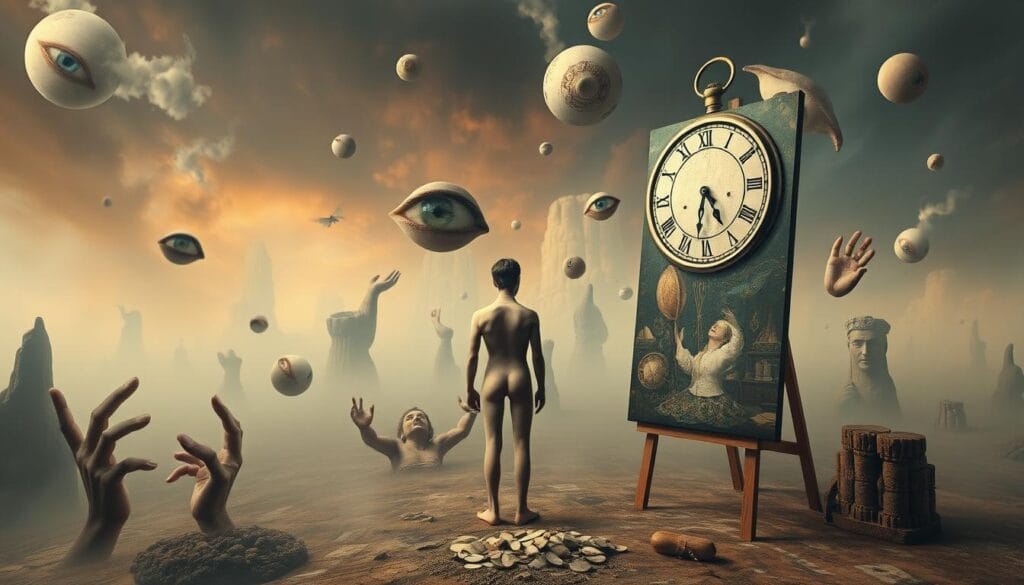Last spring, I stumbled into a living room that stopped me mid-sentence. A friend had replaced her predictable gray sofa with a velvet couch shaped like giant lips, surrounded by floating shelves that defied gravity. “It’s my Alice in Wonderland phase,” she laughed. That moment sparked my obsession with how imaginative design can turn ordinary rooms into portals of possibility.
This isn’t just about furniture – it’s a cultural reset. Nearly 100 years after Salvador Dalí’s melting clocks challenged reality, we’re craving that same boldness in our spaces. Why? Because life feels heavier than ever. We need playful escapes that spark joy without requiring a museum membership.
I’ve watched clients light up when they realize their bookcase could resemble a cascading waterfall or their coffee table could mimic a cloud. These aren’t gimmicks – they’re conversation starters that rewire how we experience daily life. The best part? You don’t need a trust fund or a penthouse to try it.
Over the next few sections, we’ll explore how to:
- Blend dreamlike elements with functional furniture
- Use color and texture to create depth and mystery
- Incorporate affordable surrealist touches that pack personality
Whether you’re revamping a studio apartment or a suburban house, this approach turns walls into canvases and ceilings into skies. Ready to ditch the rulebook?
Understanding the Origins of Surrealism
Ever wonder how a melting clock became more than just art? It started in smoky Paris cafés where writers and painters gathered after World War I. They weren’t just rebelling against war’s horrors – they wanted to redefine what reality meant through wild creativity.

The Birth of the Movement
Poet André Breton lit the fuse in 1924 with his Surrealist Manifesto. He believed logic had failed humanity, so artists should embrace dreams and randomness. Imagine scribbling thoughts without filtering them – that’s “automatic writing,” their early experiments in unlocking the subconscious.
Influential Figures and Early Ideas
Salvador Dalí didn’t just paint weird clocks. He and others like Max Ernst created visual paradoxes that made viewers question their senses. What began as poems evolved into paintings where furniture floated and landscapes warped. These pioneers showed how art could reveal deeper truths about human nature.
Today, their century-old ideas feel fresh again. We’re drawn to designs that mix practicality with mystery – like a chair that resembles a lobster or wallpaper with impossible perspectives. It’s proof that great art never stops inspiring new ways to live.
Essential Elements of Surreal Home Decor
Let me tell you about the time I saw a bookshelf grow tentacles. A client wanted their space to feel “deliciously confused,” so we blended Salvador Dalí’s playful spirit with modern practicality. The magic lies in three core ingredients: warped familiarity, chromatic daring, and rule-breaking pairings.

Melting Clocks, Bold Colors, and Unexpected Combinations
Those droopy timepieces aren’t just art history – they’re conversation starters. Try wall decals that mimic melting wax near a functional clock. Pair them with citrus-orange throw pillows against deep navy walls. The clash between ordinary and bizarre creates that “wait, what?” moment guests adore.
Color acts as your secret weapon. I once painted a ceiling glowing lavender to make rooms feel taller. Combine matte black furniture with neon-yellow vases. These choices don’t just look bold – they reshape how we perceive spaces.
Infusing Art and Imagination in Every Detail
Think beyond framed prints. A client’s boring hallway became an Alice-in-Wonderland scene using skewed mirrors and floating shelves. Optical illusions work wonders – try peel-and-stick wallpaper that turns flat walls into endless staircases.
My favorite trick? Mix textures like velvet chair covers with glass tables shaped like raindrops. It’s about creating little surprises that make daily life feel enchanted. Remember: your space should whisper, “What if?” at every turn.
Curating and Displaying Your Whimsical Art
What if your walls could tell stories that bend reality? I recently helped a client turn their bland entryway into a portal of curiosity using strategic art placement. The key lies in balancing chaotic creativity with thoughtful curation – like pairing a Dalí-inspired melting clock print with minimalist line drawings.
Creating a Dynamic Gallery Wall
Start by laying frames on the floor to experiment with layouts. Mix oversized surrealist art with smaller abstract paintings. I love using mismatched frames – try gold baroque borders next to sleek black rectangles. For a playful twist, hang one piece upside-down or tilt it slightly. This creates the illusion of movement, as if your artwork is floating off the wall.
Effective Lighting and Arrangement Techniques
Install adjustable track lighting 18″ above your gallery wall. Angle spotlights to highlight textured brushstrokes in oil paintings while softly illuminating quieter pieces. Remember: shadows add drama! Leave 2-3″ between frames for breathing room. Cluster three small art pieces near eye level to form a focal point, then radiate outward with larger works.
Pro tip: Use command strips to test layouts without nail holes. Rotate pieces seasonally – that whimsical portrait might shine brighter beside autumn-hued abstracts. Your walls should evolve like dreams – unpredictable yet purposeful.
Modern Surrealism in Interior Design
Last month, a client asked me to turn her boxy dining area into a “dream you can eat in.” We achieved it using chairs that seemed to melt into puddles – yet remained completely sturdy. That’s the magic of today’s surrealism trend: designs that dazzle while serving real-life needs.
Furniture That Works While Wowing
Gone are the days of choosing between fun and function. I recently sourced a coffee table shaped like a giant paint palette – its curved edges doubled as phone chargers. Look for pieces with hidden storage in unexpected places, like ottomans resembling stacked books. The trick? Prioritize ergonomics first, then layer on whimsy through bold colors or asymmetrical legs.
Accessories That Spark Joyful Rebellion
Your room’s personality lives in the details. Try pairing a neon-green floor lamp with a rug mimicking spilled ink. I’ve found that mixing matte and glossy finishes creates depth – think ceramic vases beside velvet throw pillows. For an instant conversation starter, hang a mirror framed with plastic fruit or install floating shelves that appear weightless.
As experts at BHG suggest, surreal spaces thrive on contrast. Balance wild elements with neutral walls or simple linens. Remember: every item should whisper, “Why not?” while still letting you live comfortably. That’s how ordinary rooms become galleries of daily delight.
